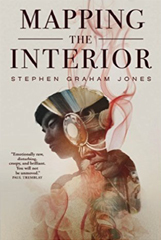 I recently came into a little bit of money, and to celebrate, I did something I rarely do: I bought some new books from Amazon. Usually I settle for the used books I can pick up here and there. Not this time. This time I picked up several books from my ever-growing Must Read list, including this novella from Stephen Graham Jones, an author of Blackfeet ancestry. This was my introduction to his work, and it certainly made me want to read more by Jones.
I recently came into a little bit of money, and to celebrate, I did something I rarely do: I bought some new books from Amazon. Usually I settle for the used books I can pick up here and there. Not this time. This time I picked up several books from my ever-growing Must Read list, including this novella from Stephen Graham Jones, an author of Blackfeet ancestry. This was my introduction to his work, and it certainly made me want to read more by Jones.
Mapping the Interior is a novella narrated by a poor Native American boy who suddenly finds himself contending with the ghost of his own father, the victim of a mysterious drowning many years before the story takes place. Junior, as he is known to his family, lives with his widowed mother and epileptic little brother Dino (or Deener, as he endearingly calls him)—his mother is somewhat distant, having never fully recovered from her husband’s death, and Junior feels obligated to look after his brother, who is often the subject of bullying because of his illness, shyness and learning impairment. Now living off the reservation thanks largely to his father’s death, Junior and his family deal with the poverty and loneliness of their new life, as well as their growing disconnection from their Native heritage. When Junior’s father’s ghost begins to appear to him at their new residence during his sleepwalking episodes, he must figure out whether this is a blessing or a curse.
What I most love about this story is how authentic the narrator’s voice is. I don’t just mean that he perfectly captures the spirit (no pun intended) of a modern Native American youth, although he does do that. I mean that he comes across as a real kid, with the cadences of his thought patterns feeling genuine, stripped of the pretentiousness of adulthood, oddly unique without being forced. Anyone who regularly reads this blog will know that one of my major pet peeves in genre fiction is when child characters are not fully developed, and when they are clearly only there to serve the plot. That’s generally less of an issue when the child character is the narrator, so Jones did have a slight advantage there, but still, this is the kind of child character I adore: he is innocent and precocious, noble and self-involved all at the same time. He is, in other words, a real human child, full of the complexities and contradictions that all children have. Which makes his struggle to understand himself and his place in the world all too familiar.
Jones’s story doesn’t delve too far into the arcane aspects of Native American history and tradition, which is perfectly in keeping with the fact that Junior is largely disengaged from and oblivious to his own culture. While he is clearly impressed with his father’s fancy dancer costume and accoutrements, he is also understandably intimidated and even frightened by them, especially as he begins to recognize that his father may not necessarily have brought himself back from death for benevolent reasons.
Mapping the Interior is a book that dissects and demystifies the myth of the always patient, sympathetic and unselfish Native without disparaging the culture as a whole, which only a Native writer could probably pull off. Moreover, it’s a truly creepy piece of writing, which makes Stephen Graham Jones a vital and unique voice in the horror fiction community. At $8.00 a pop for a new copy on Amazon, this may seem a bit high for a 112-page novella, but trust me, this is quality publication. The cover bears a beautiful illustration by Greg Ruth, and its texture is wonderfully velvety to the touch, such that I have spent countless minutes simply running my fingertips over it and marveling at its softness. If you’re at all a fan of actual hard-copy books, this is one worth having in your personal library, and worth reading, again and again.
Grade: A
Advertisements Share this:




